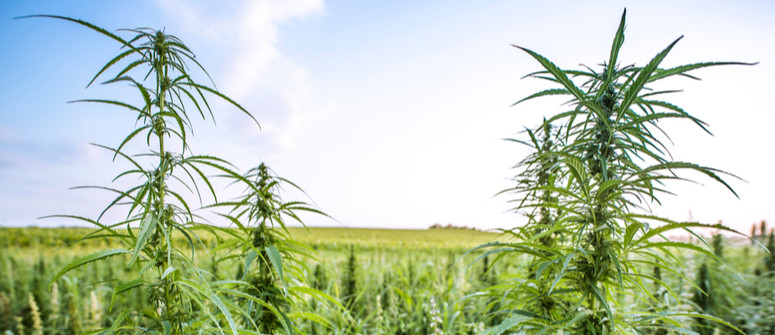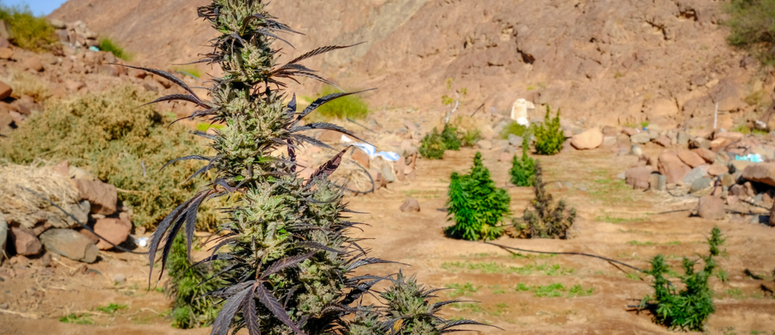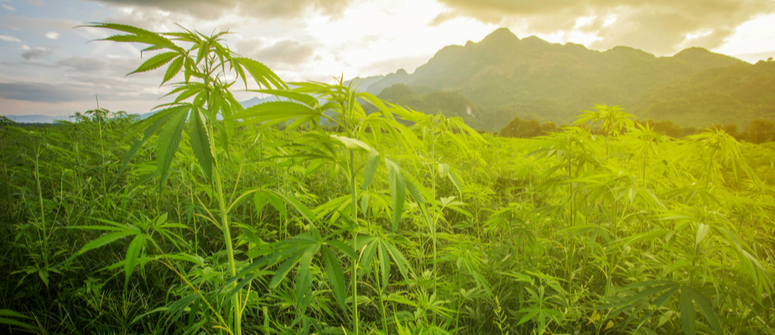Top 10 landrace strains

Landrace cannabis strains are feral forms of weed that have adapted to different conditions all over the world. These strains — and their first-generation offspring — exhibit some unique traits that offer a completely different experience to modern cultivars. They offer rare tastes and highs that both blast the body and elevate the mind.
Contents:
All modern cannabis genetics have one thing in common: they stem from wild specimens, known as landraces, that can be found all over the world.
These wild varieties feature unique traits they gained after adapting to the challenges of different environments. The Kush you smoked last night, and the Gorilla currently growing in your garden, all have landrace ancestors, and some of their most notable traits can still be traced back to those predecessors.
Those landrace strains may look quite different from our modern selection, and many might underestimate them on first glance. However, they still hold up to this day, and there are quite a few you should keep on your radar.
What Are Landrace Strains?
Landrace strains, in short, are the original cannabis strains we derive our modern varieties from today. They were first found in various regions of Thailand, South Africa, and Mexico, and could be distinguished by the individual traits they picked up to deal with their environment.
Although humans introduced cannabis to the rest of the planet, landrace strains are feral specimens that adapted and thrived in the wild. Their ability to spread, of course, can be heavily credited to birds and animals that ate their seeds and spread them around. Since this gave them the chance to develop unique, appealing characteristics, they came to possess cannabinoid and terpene levels that made them desirable to growers and breeders.
Realizing this, strain hunters in the mid and later 20th century would travel the planet in search of untapped landrace genetics. Once discovered, they would give them to growers who would add their traits into the ever-increasing cannabis gene pool, giving rise to new generations of exciting cultivars.
We talk about those strains all the time, though. Considering that, we’d like to take some time to focus on those pivotal landrace strains. These varieties are mainly the first-generation varieties that stem from wild specimens found thriving in nature. They’re the closest you’ll get to true landrace genetics today, though, and we consider them accordingly.
Top 10 Landrace Strains
The 10 landrace varieties below are the most famous wild genetics and direct descendant strains to date. They serve as the genetic foundations to many of the modern cannabis cultivars that we know, love, and grow.
Durban Poison
Durban Poison stems from a wild sativa landrace specimen found near the South African port city of Durban. Pioneering strain hunters travelled to the region specifically in search of wild cannabis plants holding untapped genetics.
After locating beautiful sativa specimens in the wild, the team returned to the international cannabis hub of Amsterdam. Here, they began crossing the strain with indica genetics. After producing a stable phenotype they were happy with, they named the progeny Durban Poison.
Since the landrace’s discovery and Durban Poison’s inception, many seed banks have created their own versions of the strain, still using the original genetics to create new cultivars today. In fact, both Girl Scout Cookies and Cherry Pie, legendary varieties in their own right, both stem from Durban Poison.
This sativa-dominant prizefighter packs high levels of THC, around 24% in the best plants. After a few hits, it imparts a cerebral and energetic high that motivates the mind. These flowers provide a great option as a wake and bake strain to get the day started right. The spicy, sweet, and fruity terpenes also go down well in edibles and extracts.
Durban Poison produces rewarding returns both indoors and outdoors. It reaches a medium indoors, likely not much higher than a meter and a half, yet surges to 3 meters when grown outside. Expect to fill up your stash jars after a flowering time of 8-9 weeks,
Early Maroc
This towering landrace strain stems from wild genetics that adapted to the arid and hot conditions of Morocco. In response to this rather harsh climate, these plants developed a slender and tall stature, along with high trichomes levels to protect themselves against the stress of UV radiation.
After locating the original strain in the wild, breeders ran seeds within controlled growing facilities in the West. They were immediately impressed with its vigorous growing pattern and gigantic vertical colas — they knew it held promise.
This pure sativa specimen produces moderate THC levels of 17%. Each toke sends an energetic shockwave through the central nervous system, but its potency doesn’t overwhelm users. Instead, it tends to fuel creative projects and deep discussions.
Early Maroc produces large and towering colas rarely seen in other varieties. They are literally pillars of pure bud that shoot up vertically with little lateral growth. These impressive flowers churn out a viscous resin loaded with tastes and scents of pepper, strawberry, spice, and candy.
This variety has maintained its feral nature. Although it grows poorly indoors, it unleashes its full potential when grown in the elements. In those situations, it’ll treat cultivators to yields of up to 450 g/plant.
China Yunnan
This high-quality landrace stems from the Yunnan province of China, hence the name China Yunnan. It’s one of the warmest regions in the country, sitting in the south of China and bordering Vietnam, Laos, and Myanmar.
Strain hunters discovered this feral specimen while trekking through the province in search of cannabis plants growing close to their ancestral homeland. Once they got a hand on it, of course, they couldn’t get enough, and we’ve seen descendants of it floating around ever since.
China Yunnan features around 80% indica genetics and only 20% sativa. Its flowers possess varying levels of THC and usually clock in anywhere between 12-18%. They also possess CBD levels of between 2-3%. When smoked, these blossoms exert a peaceful and euphoric high that melts the body and elevates the mood.
Even though it’s a hybrid to some degree, it displays a morphology more typical to indica plants. Its fan leaves feature thick fingers, and the canopy extends laterally almost as much as it does vertically. This bush-like landrace produces thick and dense buds completely coated with trichomes and resin.
Breeders have successfully cultivated China Yunnan indoors and outdoors. Indoor plants produce medium yields after a flowering time of 8-9 weeks, and pants grown outdoors in beds and containers churn out a good harvest towards the end of September.

Acapulco Gold
Acapulco Gold came to be in the, well, Acapulco region, which is located along the Pacific coast of Mexico. The strain adapted to the blazing temperatures of the dry season and the heavy rainfall of the wet season. It developed a resilience that makes it incredibly attractive to breeders, as it laughs in the face of heatwaves and mould infestation.
Its name originates from its golden tone flowers; these small and compact nuggets contain medium levels of THC and a complex terpene profile that lights up taste buds. After taking a hit, you’ll experience waves of spice, earthiness, sweetness, and musk through your nose and mouth. These flavours become particularly apparent when vaporizing the flowers, especially since most of them get burnt off when you smoke.
Acapulco Gold possesses 70% sativa genetics, so its high gets the neurons firing and serves to wake up the mind. It pairs nicely with a cup of coffee in the morning, and can put some pep in your step before going out on the town. In moderation, then, this productive daytime strain will keep you in a state of razor-sharp focus when ticking off daily tasks.
This hardy landrace produces thick and tapered flowers in abundance. Indoor plants grow to a height of 110cm and offer a yield of 500g/m², and you should prepare to harvest those 9-10 weeks after the beginning of the flowering phase. Plants cultivated outside grow up to 200cm, and produce a medium yield during the latter half of October.
Mozambica
Mozambica, a sativa-dominant landrace strain originates from the coast of Mozambique, situated in East Africa. The strain contains anywhere from 90-100% sativa genetics, meaning some forms are pure sativas, and others offer a hint of indica. It’s also known to healers of the region as “nbanje” or “soruma”, and the plant is often used to make a medicinal tea.
Mozambica boasts a hardy genetic profile. It gained this trait by adapting to the intense wet season, spanning from October until March, and the dry season that makes up the rest of the year. In turn, growers can successfully cultivate this strain in wet and damp areas of the world where many strains fall prey to mould. It also thrives in warm and dry regions and handles heat waves with ease.
This feral variety grows to tall and towering heights. Although some cultivators might enjoy exceptionally large indoor spaces, it comes into its own when planted outdoors in large containers and raised beds. Here, it develops an expansive canopy and puts out a huge yield following a flowering period of 13 weeks.
Hindu Kush
Hindu Kush stems from the mountain range that shares the same name, an 800 kilometre spine of towering rock that runs from Afghanistan, through Pakistan, and into Tajikistan. The strain hunters that first brought these genetics back to the Western world would send waves through the cannabis community that still crash against the shores of the industry today.
These pure indica genetics set the stage for some of the greatest cannabis strains ever known. Breeders harnessed them to create OG Kush, Purple Kush, and a plethora of other legendary strains that have maintained their own legacies.
The original Hindu Kush, though, is revered for a reason. It produces large and tall colas abundant with trichomes, pistils, and sharp sugar leaves, giving it a radiant presence amongst other strains. These big flowers offer a potent punch, too, with an average THC content that ranges from 18-20%. The effects can vary, too; less potent plants cast a heavy high over the body and clear the mind, while those with more THC sedate the mind even further, making these flowers ideal for quiet evenings.
This bush-like indica maintains a small height both indoors and outdoors, mainly attracting covert growers and those with limited space. It produces a medium yield after a brief flowering stage of 7 weeks indoors, and outdoor growers should prepare to harvest these sweet and fruity flowers during the end of September.
Thai
Thailand serves as the homeland to some of the best sativa weed on Earth, including its namesake product Thai.
This strain offers a buzzing cerebral experience that’s perfect for daytime use. Smokers tap into the motivating traits of Thai when creating music, painting art, writing books, or whatever else drives them. As a 100% pure sativa variety, breeders have harnessed the Thai landrace to create equally energetic cultivars such as Northern Lights and Chemdawg.
Bush-whacking strain hunters stumbled across these genetics in the 1970s, and gradually introduced them into the Western gene pool over the next two decades. Thai also bears the nickname “Thai Sticks”, as locals traditionally dried out these buds and tied them into long resinous sticks.
This exciting landrace possesses several traits that made it extremely attractive to breeders when it arrived in the West. For one, its narrow and long buds give off pungent aromas of earthiness, chocolate, citrus, and wood. Its high levels of THC synergise with the terpenes that underpin these smells to produce a clear-headed and productive high. Users describe the experience as euphoric, uplifting, and even psychedelic in high enough doses.
This tall and thin specimen thrives outdoors in polytunnels, greenhouses, and garden beds. Watch it rise to a tall height and produce a large canopy that grows heavy with buds, growing steadily over a period of 14-20 weeks. In turn, this strain is suitable only for warmer regions with a long growing season, as the seasonal transition in colder climates will shut down this plant before it’s ready.
Afghani
This hardy pure indica landrace, known simply as Afghani, derives from the Hindu Kush mountain range, specifically within the borders of Afghanistan.
Also known simply as Afghan, strain hunters apparently got their hands on these seeds and smuggled them out of the country shortly before the Soviet invasion of the late 1970s. Acquiring these seeds didn’t just temporarily add some flare to the gene pool. In actuality, Afghani genetics laid the groundwork for cultivars such as Amnesia Haze and various other popular modern phenotypes.
Much of the hash crafted in this region derives from outstanding Afghani landrace specimens, and it’s no secret the Arab world has been crafting the best hash on the planet for centuries. Smokers in other countries go to great lengths to get their hands on these premium imports, and Afghani genetics are precisely the reason.
Its small and compact nuggets produce medium levels of THC, and while this balance won’t blast you into outer space, you’ll still feel a heavy wave of euphoria crash over your body. You’ll be feeling relaxed and worry-free overall, and delicious tastes of spice and earthiness will accompany these pleasant effects.
Its robust and durable genetics make Afghani easy to grow in any environment. Indoor plants maintain a short height and produce up to 400g/m² after a flowering time of 7-8 weeks. Outdoor plants surge up to 200cm in height, and you should prepare to harvest their medium yields during the last week of September.

Colombian
Colombian, a pure sativa specimen remains a classic in the world of weed.
It surged in popularity in the 1970s and 80s and helped to fuel the demand for higher quality sinsemilla buds. After getting a hold of these genetics, breeders created a generation of cultivars that changed the game forever. All of a sudden, strains such as AK-47, Haze, and the original Skunk started to emerge, and the cannabis landscape was never the same.
This Colombian phenom combines high levels of THC with a complex yet complementary array of terpenes. Although its effects are prized, cannabis connoisseurs often seek this strain just to experience its tantalizing flavours. Every hit sends notes of skunk, lime, sweetness, and lemon across the tongue. Cannabis chefs save these flowers only for their best dishes.
After experiencing its unreal terpenes, users quickly feel a jolt of energy coursing through their system. Its euphoric, uplifting, and focused high serves almost as a nootropic. Enjoy these buds throughout the day to stay on top of your game, or take a few puffs at night when you want to hit the city with your friends & burn the midnight oil.
Overall, growers rate Colombian as difficult to grow, so if you want to experience these flowers, you need to earn them. These tall plants thrive outdoors and require a long and warm growing season, so steer clear if you’re in a cooler region.
You’ll also need to fortify your garden with companion plants such as lavender, dill, and basil to attract protective insects and deter pests. Expect to harvest large yields during November whether you’re indoors or outside.
Jamaican Lambsbread
As one of the most famous strains in Jamaica, even Bob Marley himself is reported to have ranked Jamaican Lambsbread among his favourites. This variety stems from a pure sativa landrace thought to have adapted to the Jamaican climate after arriving from Africa. Following integration into breeding programs, Jamaican Lambsbread helped give rise to progenies such as Black Tuna and Lamborghini.
This strain packs massive levels of THC and lands a fast-acting sativa buzz to the dome. Coming in hot with a THC content ranging from 21-25%, it offers a powerful high for even the most seasoned of smokers. Beginner blazers looking for an intense experience should take things one toke at a time. However, tastes of pine and lemon make these flowers a treat for the tongue, and you may be tempted to take more hits than you can handle.
Jamaican Lambsbread grows tall and lanky. It grows well in the heat of greenhouses and under full sun. When treated to these conditions, along with some high-quality soil, it’ll churn out massive yields by November.
Landrace Genetics Underpin Everything We Love About Cannabis
These powerful landrace genetics don’t just produce unique effects of their own, they underpin hundreds of modern cultivars grown all over the world. Cannabis’ ability to adapt to all conditions, the perseverance of strain hunters, and the ingenuity of breeders all converged to bring about the modern era of weed, and we can’t be thankful enough. So what are you waiting for? Show your thanks to your favorite strain’s ancestors & start growing one of them today!




